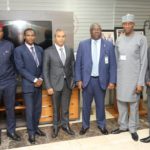
A week today, Air Peace flight landed at the international runway of the MurtalaMuhammed International Airport (MMIA), Lagos at about 8:30 pm. It took the aircraft about 30 minutes to taxi to the General Aviation Terminal (GAT) the final destination of the flight.
Before it landed, the aircraft queued (hovered) with both international and local flights that were programmed to land on the same runway, while the domestic runway, R18L was idle due to lack of airfield lighting.
So, one of the two runways of the busiest airport in the country, the Lagos airport remains non-functional from 6:00 pm to 7:00 am everyday due to the absence of runway lights since after its rehabilitation in 2007.
Airlines said that they burn so much fuel taxiing from the international runway, 18R to the domestic terminal of MMA2 and GAT. Few years ago, the Managing Director of IRS Airlines AlhajiIsiyakuRabiu said besides the wear and tear on the equipment, domestic airlines burn about N2 billion worth of fuel annually taxiing from the international runway to the domestic, which takes an aircraft about 15 to 20 minutes.
In addition to domestic runway that has no airfield lighting in Lagos, there are17 other airports without the facility. So flights cannot operate there after 6:00 pm. For airlines to operate to these destinations, they must schedule their flights to depart from such airports at day time.
An industry stakeholder, who once headed the Nigerian Civil Aviation Authority (NCAA) told THISDAY that one of the major limitations to the optimum utilisation of commercial aircraft in Nigeria is the lack of airfield lighting or runway lighting. These are lights that guide the aircraft to landing and taking-off on the runway. Unfortunately only five airports out of 22 airports being managed by the Federal Airports Authority of Nigeria (FAAN) and three airports built by the state government have airfield lights that are being utilised currently. These airports include the once in Lagos, Port Harcourt, Kano, Kaduna, Abuja, Kebbi and Uyo. Some other airports have the equipment but they are either redundant, in a state of disrepair or are waiting to be connected.
Lack of functional airfield lighting is a major setback for Nigerian airlines because they cut off about four or five operational hours from the daily flights of an airline designated for schedule operation. Industry experts who spoke to THISDAY said they are shocked that despite the importance of this equipment for safe airline operation, government has not been able to install it at all the airports and most of those installed in the past are in disrepair.
However, the Minister of State, Aviation, Senator HadiSirika said that the priority of the Buhari administration is to provide safety critical equipment and facilities at the airside of the airports and this include landing aids such as the airfield lights, rehabilitation of the runway and others. FAAN also said that it had started the repair and installation of the lights at some of the airport runways.
Another setback to flight operations in Nigeria is poor navigational aids including communication in the airspace. THISDAY spoke to a pilot on Tuesday, who admitted that navigational aids such as instrument landing system (ILS) has improved, but noted that the major challenge now is communication. He said that the old blind spot where a pilot may not experience communication signals is back.
Communication is very critical to flight safety and this has been a major problem in Nigeria’s airspace over the years. Although Nigerian pilots said they have become innovative in operating through the airspace with those lapses overtime, but this has remained a danger to safety of flights.
The Nigerian Airspace Management Agency (NAMA) recently said it has concluded arrangements with Jotron AS, a leading manufacturer of professional communicationequipment, for the deployment of four stand-alone high-powered, Very High Frequency (VHF) long range communication radios. Each of this equipment would be installed in Lagos West and Lagos East as well as Kano West and Kano East Area Control Centres (ACCs).

Already, NAMA has conducted a successful inspection and Factory Acceptance Test (FAT) of the equipment in Norway.
Although there are no timeline for the installation of this equipment, the managing director of NAMA, Capt. FolaAkinkuotu who led the team to Norway said the equipment would adequately solve the communications problem in Nigeria’s airspace.
Pilots acknowledge that ILS has improved but they note that to overcome the adverse weather which often lead to flight cancellations the federal government should expedite action on the installation of Category 3 ILS at least at major airports in the country besides Kaduna that already has the equipment.
This will enable flights to land at zero visibility in most of the airports and help to overcome the annual impediments to flight operations by the Harmattan haze.






